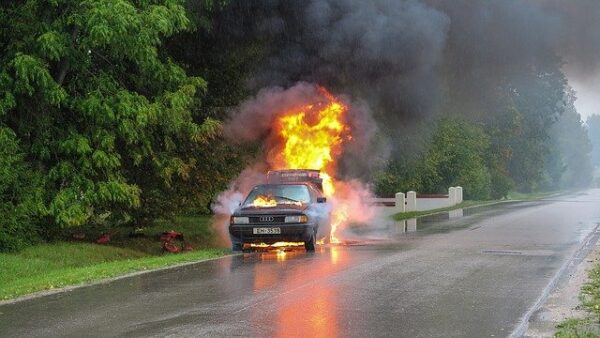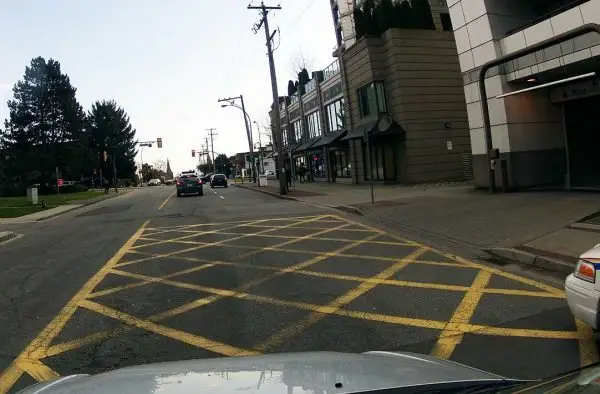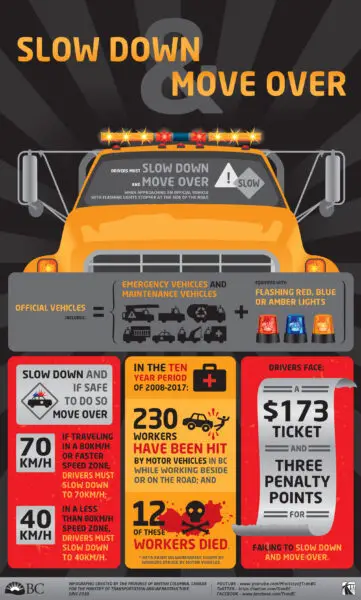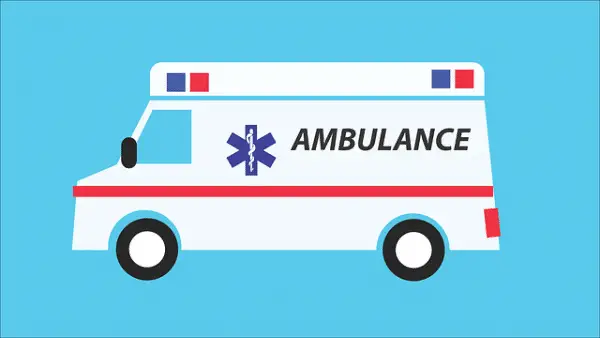In Beautiful British Columbia, we have specific rules and guidelines around emergency vehicles and this article will go through the proper BC emergency vehicle etiquette.
It’s important for everyone, including new drivers of course, to familiarize themselves with the proper BC emergency vehicle etiquette and protocols.
It’s always awkward for everyone when an emergency vehicle is coming with its emergency lights and sirens activated.
Emergency vehicles are just one of the many reasons why you should look from left to right before crossing intersections. This is especially true if you are the first vehicle at an intersection when your light goes green.
BC Emergency Vehicle Etiquette
Here’s just one little example of a time when the vehicles needed to stop for a green light, because an emergency vehicle was coming.
Remember to check your mirror to make sure the vehicle behind you isn’t going to rear-end your vehicle. You can’t be sure that the driver behind you is alert and prepared to suddenly stop.
Proper BC Emergency Vehicle Etiquette Includes…
When the emergency vehicle with lights and/or sirens is coming
- Pull over to the closest curb or edge of the roadway. This is usually to your right, but might be to your left if you are on a one-way street for example. Then, STOP completely. Do this safely and watch the car behind to make sure you won’t be rear-ended.
As there is obviously already an emergency, the last thing that anyone needs at that moment is another emergency/collision. If the emergency vehicle is going in the same direction as you, or the opposite direction, you should still pull over and stop.
The only exception is when you’re on a divided road, like a freeway. Then, it makes no sense for you to stop, as the vehicle will not be potentially crossing cement medians to drive around traffic.
In the following photo, each driver has pulled over to their closest curb. This makes a path in the middle for the emergency vehicle to fit through.
The vehicles going in the opposite direction don’t need to pull over and stop. That’s because there’s no way an emergency vehicle on the other side of the cement barrier would cross the barrier to get around a traffic jam.

Sometimes the emergency vehicle drives on the wrong side of the road as this is the only available space in rush hour, for example.
If you can’t pull over, then just stop where you are. When stopped, its predictable for the emergency vehicle driver. The driver can plan a route around you.
If you keep moving, it will be difficult for them to figure out how to get around. They have no idea what you are going to do.
In the following photo, both directions of traffic should stop for the emergency vehicle, because there’s no divider. This means the vehicle may utilize any part of either direction.

Sometimes you may need to get out of the way. For example, if the emergency vehicle is behind you close to an intersection, you may be able to turn right and then stop. This would free the way for the emergency vehicle.

BC Emergency Vehicle Etiquette – BC’s Slow Down and move over laws
British Columbia has a bad record of first responders who have been injured or killed on the roads. These events happened when first responders were just trying to help others. For this reason, BC’s Slow Down & Move Over Laws became a thing.
The laws are designed to keep first responders safe while they deal with emergencies in our communities. Drivers were failing to slow down and/or move over. People got hurt or killed.
RCMP would like to remind drivers of their requirements when approaching or being approached by an emergency vehicle with its lights and sirens engaged.
Section 188 of the Highway Traffic Act requires drivers being approached on an undivided roadway, from front or rear, by an ambulance, fire truck, emergency or police vehicle with flashing red lights and sirens to yield the right of way to the emergency vehicle by pulling over to the right as far as possible and stopping until the emergency vehicle has passed.
RCMP
Follow These Laws to do Your Part
- If you’re driving on a road where the speed limit is 80 km/hr or higher, slow down to 70 km/hr.
- When you’re driving on a road where the speed limit is below 80 km/hr, slow down to 40 km/hr.
In situations where there is another lane going in the same direction, move into it if safe.
The Slow Down and Move Over Law Applies to These Vehicles
- Stopped police vehicles
- Ambulance vehicles
- Fire vehicles
- Commercial safety and enforcement vehicles
- Transportation inspectors
- Park rangers
- Conservation officers
But this is probably a good rule to follow for ANY type of vehicle/person stopped on the side of the road.
Penalties for not slowing down and moving over in Beautiful British Columbia are $173 + 3 penalty points.
Read more: How ICBC Points Work
Between 2001 and 2007, 21 emergency workers were injured or killed on B.C. roads.
BC Emergency Vehicle Etiquette – Emergency Vehicles Without Lights and Sirens
I know that new drivers often wonder about emergency vehicles that don’t have lights and sirens. You can treat these vehicles just the same as any other regular car.
It’s only when there are lights flashing and/or sirens activated that you need to stop and/or get out of the way.
Do Not Block Emergency Vehicle Driveways/Entrances
Check out the road markings here
What’s up with this nice design on the road?

This warns drivers not to stop on these lines. It means do not block the intersection/driveway. Usually, this is found at the entrances to emergency vehicle driveways, although you should avoid blocking any intersection.
If there is backed-up traffic and/or red light, stop in front of the lines, or behind them, but not on top of them.
Q: Hi, let’s say an emergency vehicle with its lights flashing and/or sirens on wants to get through but it cannot do so unless you get out of its way. (The traffic is very heavy and there is no shoulder either)
Are you legally allowed to move into the intersection (or even turn) to make room for the emergency vehicle even if the light is red and/or signs prohibit a turn? I don’t believe there is any law saying you can get away with breaking laws whenever there is an emergency vehicle!
In my experience, sometimes the emergency vehicle (I’ve seen this with ambulances mostly) has turned off the siren/lights until the light has gone green, and then they turn it on again and expect the cars to then move out of the way. So that tells me they do not want people doing things that are dangerous if getting out of the way is literally impossible. No one really wants emergencies, but one is better than two.
My question was based on what I saw today. Two cars had to go through the red light (first, they stopped halfway in the intersection) just so that a police vehicle could get through. Two cars (on a two-lane road) were stopped behind the stop line when the light was red. The police car then arrived behind them. Then they moved halfway into the intersection. Once the police passed by, they exited the intersection by going straight (basically, running the red light).
I think it would be safer to try to turn right on the red light, even if it’s a wide or “improper” kind of turn. I have done that before in my life.
I agree with you that turning right would’ve been better but what if right turn on red was not allowed? It’s my first time seeing something like this so it got me wondering.
I think that if there’s no right on red, it’s for a reason (like bad visibility, a hill or a curve.. ) however if the lights and sirens are on AND any car coming around the hill/curve or in that area has stopped due to noticing the emergency vehicle, then it suddenly becomes rather safe to turn right on the red (although may be technically illegal).
The emergency vehicle is obviously busy and trying to get somewhere, he’s not going to stop and give you a ticket. But the problem would be if there was a crash resulting from your right turn.. would you be at fault. It is an interesting situation. If the lights and sirens are still on I would take that to mean “Get out of the way NOW” Not like the Ambulance I saw that turned off the light/siren until the light went green.
I guess the best thing to do is use common sense and realize that it is very important for the emergency vehicle to get to where it’s going as quickly as possible, SAFELY.
If you knew it was a matter of life or death then a traffic ticket or infraction of the law should not seem like something to worry about compared to the other person waiting for the emergency vehicle! I don’t think any police in their right mind would give you a ticket for breaking the law to get out of the way as long as it was done safely.
Anyway if I knew I could save someone’s life by paying for a right on the red light ticket I would happily pay it. Just me. Just be careful. Sometimes the other cars don’t notice the emergency vehicle, especially if they’re distracted, on the phone, or have loud music playing and screaming kids in the back seat, etc.
ICBC Says (From the Learn to Drive Smart Manual)

Conclusion – BC Emergency Vehicle Etiquette
Don’t overthink this. BC emergency vehicle etiquette exists so that hopefully, us drivers can simply get out of the way when the emergency vehicle needs to get through because someone is having a worse day than us.
But, you’re not expected to do something dangerous, like driving through a red light, to get out of the way. One emergency is enough! So, get out of the way as quickly and safely as possible. Do whatever you need to do, but keep it safe. Hope that all made sense.
Preparing for your ICBC road test? Be sure to check out my epic article: ICBC Road Test Tips For Classes 5 & 7 [Instructor Gets Deep].
Read More:
- Emergency Vehicles – ICBC
- British Columbia Slow Down, Move Over Laws
- 13 Roadside Workers Killed in BC Over Past Decade

Carmen Cohoe
Carmen became a driving instructor in beautiful North Vancouver at the age of 22 due to some crazy people who agreed to hire her. After that, there was never a dull moment teaching many different folks from many different places how to drive using automatic and standard vehicles and a minivan.



What are the laws/penalties for emergency vehicles misusing their sirens in Non emergency or personal cases?
I have no idea. I can try to look it up/